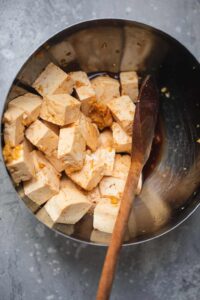Tofu has become very popular in the United States, and it is an essential element in most vegan diets. The soy-based product is incredibly versatile, and it can be used in several cuisine applications. But, where did it come from and how is it made? Here is a little history and some fun facts about tofu that you may not have known about this food that we love.
Facts About Tofu
Tofu Originated in China
Tofu was first made around 2000 years ago in China during the Han Dynasty (206 BC–220 AD). The oldest evidence of tofu making is a mural that shows tofu production that was dated to 25-220 AD.
Tofu is Made Like Cheese
One of the strange facts about tofu is that the process of making Tofu is very similar to making cheese. The process starts with soy milk. Coagulants are added to make the solids separate from the liquids. The traditional coagulant used is Nagari, which is basically magnesium chloride, and it is still used in tofu production today. The bean curds are then packed into a press, and this is where the name bean curd comes from. The pressed blocks of curd are then aged (depending on the type of tofu being made). Early eastern people actually referred to the substance as bean curd cheese.
We Don't Really Know How Tofu Was Invented
There are three theories as to the invention of tofu, but there are not really facts about tofu creation. The most popular legend is that it was created by Prince Liu An (179–122 BC) of the Han Dynasty who was an adviser to his nephew the Emperor of China. During that time, great discoveries were attributed to the rulers of the province where the item was invented. Another idea is that it was a copied technique from the dairy-milk cheese making by the Indians and Mongolians. The last theory is that someone discovered tofu when they tried to season a pot of pureed soybean soup with seawater. The salts that are used to coagulate soy milk are all found in seawater.
Tofu is Closely Tied to Buddhism
The spread of Tofu to Korea and Japan coincided with the spread of Buddhism. Buddhism believes that killing has negative karma implications for the afterlife. As a result of this belief, many Buddhists are vegetarian. Japanese Buddhist priests are responsible for bringing tofu back to Japan. Tofu provides a great source of protein, and it does not require the killing of animals. Therefore, tofu is the perfect protein source to accompany the spread of Buddhism. Tofu is believed to have arrived in Japan in the eighth century AD.
Tofu is a Japanese Word
The name Tofu is a Japanese term that is derived from the Chinese word doufu (Mandarin) that literally means curdled bean.
Tofu is a Good for You
Tofu is low in calories per serving, and it is a great source of protein, Iron, and (depending on the coagulant used) calcium or magnesium.
Benjamin Franklin Introduced Tofu to the U.S.
Ben Franklin may have been instrumental in bringing Tofu to the U.S. The earliest written record of tofu by an American comes from Ben Franklin, who wrote to John Bartram in Philadelphia from London in 1770. Franklin sent some soybeans to Bartram. He wrote in the letter that there was a cheese that could be made of the curds of the bean, and that seawater was what curdled the beans.
Tofu Was a Prized Delicacy of the Samurai
During the Kamakura Period (1182-1333 AD), tofu was a prized delicacy of the Samurai ruling class. The bean curd matched their more simple lifestyle and diet. It is said that tofu replaced fish in a lot of Japanese cuisines during this period.
Freezing Tofu Changes it
When tofu is frozen, the trapped water turns to ice crystals that puncture cell walls. The result is cavities in the tofu that give a stacked appearance. The Chinese call this thousand layer tofu. This process removes moisture and changes the molecular bonds that hold it together. When thawed the Tofu takes on a yellow color and a more tough and rubbery texture.
Tofu Became Popular in the U.S. After 1971
In 1971, Frances Moore Lappe published his book Diet for a Small Planet that dispelled the myth that animal-based protein was superior to other sources, and introduced the idea of complementary proteins to the American public. The book also taught that eating a meatless diet was better for health and for the world. This book became the best selling book on diet and nutrition that had ever been published. This was an instrumental bok in increasing the popularity of Tofu in the U.S.






Comments
No Comments